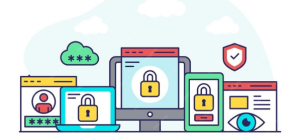In today’s interconnected world, the security of digital accounts is of paramount importance, particularly in the United States. With the rapid digitization of services and personal data being stored online, ensuring the protection of digital identities has never been more critical.
While there are numerous beliefs regarding how secure digital accounts truly are, it is essential to separate myths from realities to safeguard your personal information effectively. Understanding the most common threats and implementing best practices can significantly enhance your online security.
Digital account safety: Debunking common myths

It’s a common misconception that simply having a strong password makes your account invulnerable to hacking. While a robust password is a crucial defense mechanism, it is not infallible. Hackers employ advanced techniques such as brute force attacks, phishing schemes, and malware to breach even the most secure digital accounts.
It’s vital to complement a strong password with additional layers of security, such as two-factor authentication (2FA), to significantly enhance protection. Another myth is that only high-profile individuals or large corporations are targets for cyber-attacks.
In reality, cybercriminals frequently target average users, assuming they might have weaker security measures. Every digital account is a potential target, regardless of the user’s prominence, making it necessary for everyone to be vigilant and proactive about their online security.
The role of two-factor authentication
Two-factor authentication has emerged as a powerful tool in the fight against unauthorized access to digital accounts. By requiring a second form of verification, typically a code sent to your mobile device, 2FA provides an additional layer of security.
This makes it significantly harder for cybercriminals to gain access, even if they somehow obtain your password. Enabling 2FA across all your digital accounts is a proactive step toward securing your online presence.
Most platforms support this feature, and implementing it can greatly reduce the risk of unauthorized access. Regularly updating your 2FA methods and being aware of new authentication technologies can further enhance the protection of your digital assets.
Understanding phishing attacks
Phishing is a method used by cybercriminals to trick users into revealing sensitive information by pretending to be a trustworthy entity. These attacks often come in the form of deceptive emails, messages, or websites that appear legitimate.
Falling victim to a phishing attack can result in compromising your digital account and personal information. To counteract phishing attempts, it’s crucial to be skeptical of unexpected communications asking for sensitive details.
Always verify the authenticity of the sender before clicking on any links or providing information. Utilizing email filters and cybersecurity software can also help identify and block potential phishing attempts, bolstering the security of your digital accounts.
Realities of digital account protection in the USA
In the USA, safeguarding digital identities involves adhering to best practices recommended by cybersecurity experts. Regularly updating passwords, using complex and unique combinations for different accounts, and keeping software up to date are fundamental steps.
Additionally, being aware of the latest security threats and how to respond to them is crucial for maintaining a secure digital footprint. Recent advancements in technology, such as biometrics and AI-driven security solutions, are becoming increasingly prevalent.
Biometric authentication, which uses unique physical characteristics like fingerprints or facial recognition, offers an extra layer of security that is difficult to replicate. AI-driven solutions can detect and respond to unusual account activities in real-time, providing an edge in securing digital identities.
The importance of regular security audits
Conducting regular security audits is a proactive approach to identifying and addressing potential vulnerabilities in your digital accounts. These audits involve reviewing your current security measures, detecting possible breaches, and updating your defenses accordingly. By staying ahead of potential threats, you can ensure that your online accounts remain secure.
Engage in routine checks for unusual activity in your accounts and update security settings as needed. Keeping abreast of emerging cybersecurity trends and adapting your strategies can help mitigate risks. Working with cybersecurity professionals for thorough audits can also offer insightful recommendations and advanced protection measures.
Final thoughts: A call to action
The security of digital accounts in the USA is a multifaceted issue that requires continuous vigilance and adaptation. By debunking myths and embracing the realities of cybersecurity, individuals can take concrete steps to protect their online identities.
Implementing strong passwords, utilizing two-factor authentication, being aware of phishing attacks, and conducting regular security audits are fundamental measures everyone should adopt. As technology continues to evolve, staying informed about new security threats and advancements is pivotal.
Safeguarding your digital accounts is not just a one-time effort but an ongoing process that ensures your personal information remains protected in an ever-changing digital landscape.
